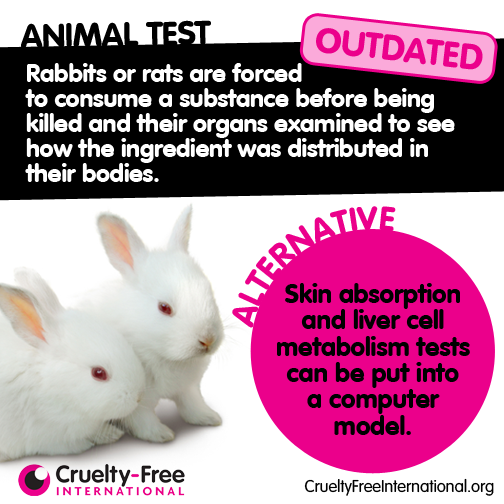It's hard to imagine any compassionate-minded person would spray window cleaner into the eyes of a rabbit or force rats to eat dish soap until it made them ill. It's equally hard to imagine that anyone would pay someone else to do these things for them. However, thousands of people effectively condone such acts each time they purchase household cleaning products that were tested on animals.
When the gory details of animal-based product safety tests are described most people cringe or recoil in disgust but they may then rationalize it as a "necessary evil." However, aside from the cruelty involved animal-based tests have another problem - they often fall short of ensuring human safety.
Indeed, the necessity and validity of using animal tests to determine the safety of chemicals has been increasingly called into question. Transferring the results of animal tests to humans has proven to be problematic and misleading in many cases. Tests involving mice for skin allergy only predict human reactions 72 percent of the time. Another frequently used animal test is the "repeated dose" test. In this test, animals are force-fed, forced to inhale or have a substance rubbed into their shaved skin every day for 28 or 90 days before being killed. Aside from being gruesome and costly, the ability to correctly predict human reactions (to drugs) using this test are only about 40 to 60 percent predictive; about as accurate as flipping a coin.
Many animal-based tests were developed over 70 years ago when the science of product safety testing was in its infancy. Given the speed of scientific and technological developments it's not hard to imagine that there are now many modern alternatives to these rather draconian tests.
So what exactly are the alternatives? In a nutshell, alternative methods are tests that use simple organisms like bacteria, or tissues and cells from humans (so-called in vitro tests), and sophisticated computer models or chemical methods (so called in silico and in chemico tests).
For example, to assess skin irritation and corrosion, reconstituted human skin models (sold commercially in kits such as EpiSkin, EpiDerm and Skin Ethic) can be used. These models are made up of small discs of skin cells grown from human skin donated as waste from cosmetic surgery and have been shown to be more predictive than the original cruel live animal skin tests.
As for replacing the error-ridden repeated dose test, it is important to step back and examine the information that this test aims to find. The key question that repeated dose studies aim to answer is: at what dose does a substance start being toxic (harmful)? Thankfully, this question can often be answered by reversing the question and asking instead whether the doses that humans are exposed come even close to the doses at which worse case toxic chemicals exert their effects. This is the threshold of toxicological concern (TTC) which may all sound Greek to you and me, but to scientists it is a well-understood principal. In fact, the TTC method was first used for food additives and research has shown it to be useful for substances that go into household products at a fraction of the time and cost of animal studies.
In the future, we can expect even more innovative alternatives. At the recent global conference on "Alternatives and Animal Use in Science" held in Prague, a German "lab-on-a-chip" company estimated that in as little as 3 years their human replication chip will be available for testing chemicals with unrivaled relevance to humans (since human tissues and systems would be replicated). A smaller chip produced by the company is already in use and mimics two organs (liver and skin), and the company is finalizing one that contains four organs that remain viable for 28 days (the length of one of the most common animal tests).
Of course, one need look no further than the dozens of cruelty-free companies to prove that it is possible to make humane household products without commissioning new tests on animals. Yet despite the availability of alternatives and the example set by these progressive and successful companies, animal tests for determining product safety are still allowed in the United States and around the world. Cruelty Free International is working to change this. A big part of that change depends on influencing consumer purchasing habits.
Whether we like it or not, consumerism shapes many aspects of our society. After all, Webster's Dictionary defines "consumerism" as "the promotion of the consumer's interests." Put a little differently, the way we spend our money communicates our beliefs, values, and interests.
Becoming a more conscientious consumer can be tricky. Companies looking to capitalize on your good intentions can issue misleading claims and logos on their products that upon closer examination are little more than imaginary friends. Just because a product label says "Not Tested on Animals" or "Cruelty Free," or has a picture of a bunny on it, does not necessarily mean that the ingredients were not tested -- it might only mean that the final product wasn't tested. Most animal testing occurs at the ingredient level, so unless a company has verified that level of testing, it's hard to be sure what animal testing did or did not occur in the development of a product.
This is why compassionate consumers should look for brands that have been certified under the Leaping Bunny program. Leaping Bunny certified brands have committed to ensuring that no animal testing is conducted or commissioned for finished products or ingredients in any phase of product development by the company, its laboratories or its suppliers after a fixed cut-off date. The Leaping Bunny is different to other 'cruelty-free lists' as companies are asked to prove their no-animal-testing claims, and appoint an independent auditor to check that this proof is watertight.
Looking for the Leaping Bunny logo is the easiest way to shop; however, certified brands are not obliged to display the Leaping Bunny logo on their products, so do check www.gocrueltyfree.org for the most up to date list of cruelty-free companies.
The beginning of a new year has always been a time for looking forward to the coming year and making a few changes for the better. If you hope for a more compassionate world, make a resolution to use your consumer power to affect change. By shopping with your compassionate values on your mind and in your heart, you can truly make a difference in the lives of animals.
P.S. Want to solidify you cruelty-free commitment? Take the Clean Up Cruelty Pledge and make the switch to compassionate cleaning by using only Leaping Bunny certified cruelty-free household cleaning products.

